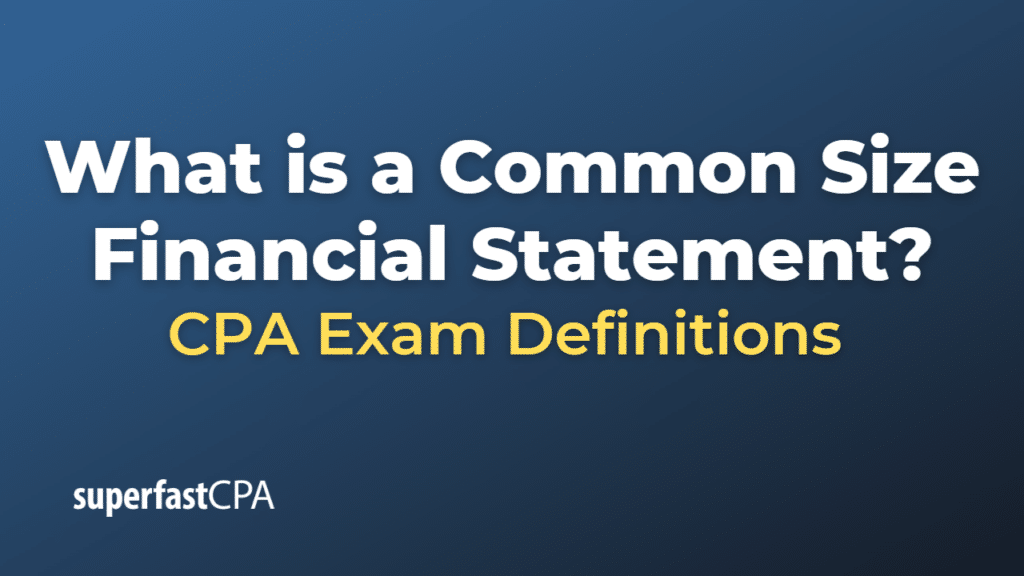Common Size Financial Statement
A common size financial statement is a financial statement in which each line item is expressed as a percentage of a common base figure. This approach standardizes the financial statement, making it easier to analyze and compare financial ratios across different companies or time periods. Common size financial statements include common size balance sheets, common size income statements, and common size cash flow statements.
- Common Size Balance Sheet: Each line item on the balance sheet is expressed as a percentage of the total assets. This helps in comparing the financial position of different companies or analyzing the trends in a company’s balance sheet over time.
- Common Size Income Statement: Each line item on the income statement is expressed as a percentage of the total revenue. This standardization facilitates the comparison of profitability and cost structures among different companies or across different time periods for a single company.
- Common Size Cash Flow Statement: Each line item on the cash flow statement is expressed as a percentage of the total cash inflows or outflows. This allows for easier analysis and comparison of cash management and liquidity among different companies or across different time periods for a single company.
By converting each line item into a percentage, common size financial statements enable a more straightforward comparison of a company’s financial structure, performance, and position over time or with other companies in the industry. This helps in identifying trends, understanding the composition of assets, liabilities, revenues, expenses, and cash flows, and evaluating a company’s financial health and stability.
Example of a Common Size Financial Statement
Let’s consider a hypothetical example to illustrate the concept of a common size income statement for two companies, Company X and Company Y.
Here are the income statements for both companies:
Company X (in thousands):
- Revenue: $500,000
- Cost of Goods Sold (COGS): $300,000
- Gross Profit: $200,000
- Operating Expenses: $100,000
- Operating Income: $100,000
- Interest Expense: $20,000
- Income Before Taxes: $80,000
- Income Taxes: $24,000
- Net Income: $56,000
Company Y (in thousands):
- Revenue: $800,000
- Cost of Goods Sold (COGS): $480,000
- Gross Profit: $320,000
- Operating Expenses: $160,000
- Operating Income: $160,000
- Interest Expense: $32,000
- Income Before Taxes: $128,000
- Income Taxes: $38,400
- Net Income: $89,600
To create common size income statements for both companies, we’ll divide each line item by their respective total revenue and express the result as a percentage:
Company X – Common Size Income Statement:
- Revenue: 100% (base figure)
- COGS: ($300,000 / $500,000) x 100 = 60%
- Gross Profit: ($200,000 / $500,000) x 100 = 40%
- Operating Expenses: ($100,000 / $500,000) x 100 = 20%
- Operating Income: ($100,000 / $500,000) x 100 = 20%
- Interest Expense: ($20,000 / $500,000) x 100 = 4%
- Income Before Taxes: ($80,000 / $500,000) x 100 = 16%
- Income Taxes: ($24,000 / $500,000) x 100 = 4.8%
- Net Income: ($56,000 / $500,000) x 100 = 11.2%
Company Y – Common Size Income Statement:
- Revenue: 100% (base figure)
- COGS: ($480,000 / $800,000) x 100 = 60%
- Gross Profit: ($320,000 / $800,000) x 100 = 40%
- Operating Expenses: ($160,000 / $800,000) x 100 = 20%
- Operating Income: ($160,000 / $800,000) x 100 = 20%
- Interest Expense: ($32,000 / $800,000) x 100 = 4%
- Income Before Taxes: ($128,000 / $800,000) x 100 = 16%
- Income Taxes: ($38,400 / $800,000) x 100 = 4.8%
- Net Income: ($89,600 / $800,000) x 100 = 11.2%
By converting the income statements into common size format, it’s easier to compare the profitability and cost structures of both companies, regardless of their size. In this example, we can observe that both companies have similar percentages for COGS, gross profit, operating expenses, operating income, interest expense, income before taxes, income taxes, and net income. This information can help investors, analysts, and other stakeholders better understand the companies’ financial performance and make more informed decisions.













